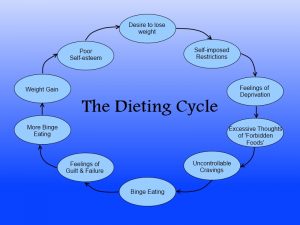What Is A Healthy Weight?
Our country is obsessed with weight. There are reasons to be concerned about weight and there are correlations between weight and health. Yes, there is a problem with obesity in this country, but there is also a problem with the way media portrays what is ‘healthy’ and more specifically what is considered ‘beautiful’ when it comes to weight and physique. Unfortunately, I feel that many people have an altered perception of what a healthy weight is.
Healthy Weight or Ideal Weight?
First, I would like to talk about the idea of a healthy weight. What is a healthy weight? Is there one healthy weight for everyone? Or is there even a healthy weight for each certain size and build? Well the truth is you can be healthy at many different weights, just like you can be unhealthy at many different weights. For example, a 35 year old woman who is 5 feet 8 inches tall and weighs 130 pounds would be a ‘healthy weight,’ but if she is not controlling her type I diabetes, that is very unhealthy. Another example, a 23 year old man who is 6 feet tall and weighs 210 pounds would be considered overweight, but if he eats healthy, regularly exercises, and is an amateur body builder, he is probably pretty healthy. As mentioned before, weight does have an effect on health, but it is not the only thing and by itself I would say is not very important. The lifestyle factors that typically lead to weight gain have a much bigger effect on health than the weight itself.
I much prefer the term ‘ideal weight’ to ‘healthy weight.’ While there is not one specific weight that is right for everyone, there are ranges of weight that are ‘ideal’ for each height and body build. This range of weight allows for the variation that is normal between each individual. You may ask why the distinction even matters between a ‘healthy weight’ and an ‘ideal weight.’ I believe the idea of ‘healthy weight’ causes people to put too much emphasis on weight and often do some very unhealthy things to get to and maintain a ‘healthy weight,’ which (surprise) is not healthy. If I were to define ‘healthy weight’ it would be the weight your body maintains when you are living a healthy lifestyle including proper eating habits, regular exercise, adequate sleep, and moderating your stress level. The problem is there is no way of calculating what that weight would be for an individual, which is why an ideal weight range works better.
The obesity epidemic in this country is not a problem with weight: it is a problem with lifestyle. If weight were really the problem, there are several ‘quick and easy’ ways to get rid of weight: you can sweat out several pounds in a short amount of time, just surgically remove the extra weight, or if you want to think outside the box just send everyone to space and then ‘weight’ is gone completely. Obviously, these things are not going to make a person any healthier and each has several risks also. My point is that individuals needs to make better lifestyle choices if we are going to have any effect on the obesity problem and become a healthier nation.
How to Calculate an Ideal Weight
An ideal weight is just that an ideal, and the real world is rarely if ever ideal. However, an ideal weight does give an approximate weight range to work towards. The way to estimate ideal weight for women is 5 feet would equal 100 pounds and for each additional inch beyond 5 feet add 5 pounds. Then when you have that number you add and subtract 10 percent to get your ideal weight range. For example a woman 5 feet 8 inches tall would calculate her ideal weight range as follows.

For men it is a little bit different: 5 feet would equal 106 pounds and then for each additional inch beyond 5 feet add 6 pounds. Then again take that number and add and subtract 10 percent to get the ideal weight range. For example a man 6 feet tall would calculate his ideal weight range as follows.

Conclusion
The idea of a ‘healthy weight’ can be misleading because you can be healthy at a variety of different weights. Having an ‘ideal weight’ to work towards can be helpful, but having an ideal weight does not mean you are healthy and being outside of the ideal weight range does not automatically mean you are unhealthy. Weight does play some part in health, but lifestyle plays a much larger part. If you would like more information about living a healthy lifestyle please read my other blogs or feel free to contact me through the website.


